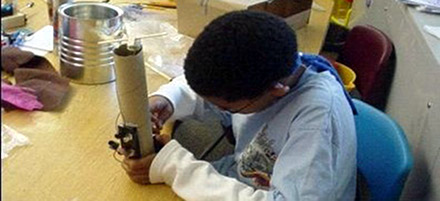
Learning Outcomes

Standards:
The following are overarching goals and objectives addressed from the North Carolina Standard Course of Study for Fourth Grade:
English Language Arts
- 2.03 Reading a variety of texts including informational books, diaries, and journals.
- 4.02 Use oral and written language to resent, discuss, interview, solve problems, and make decisions
- 4.03 Make oral and written presentations using visual aids with an awareness of purpose and audience
- 4.06 Compose a draft that conveys major ideas and maintains focus on topic with specific, relevant, supporting details by using a preliminary plan
- 4.07 Compose non fiction including expository research, logs, rules, and instructions
- 4.08 Focus revision on a specific element such as sequence of events and ideas
- 4.09 Produce work following the conventions of "Letters of Request"
Science
Goal 3 - The learner will make observations and conduct investigations to build an understanding of magnetism and electricity.
- 3.01 Observe and investigate the pull of magnets on all materials made of iron and the pushes or pulls on other magnets.
- 3.02 Describe and demonstrate how magnetism can be used to generate electricity.
- 3.03 Design and test an electric circuit as a closed pathway including an energy source, energy conductor, and an energy receiver.
- 3.04 Explain how magnetism is related to electricity.
- 3.05 Describe and explain the parts of a light bulb.
- 3.06 Describe and identify materials that are conductors and nonconductors of electricity.
- 3.07 Observe and investigate that parallel and series circuits have different characteristics.
- 3.08 Observe and investigate the ability of electric circuits to produce light, heat, sound, and magnetic effects.
The following are overarching goals addressed from the National Standards:
National Council of Teacher's of English Standards:
- 4. Students adjust their use of spoken, written, and visual language (e.g., conventions, style, vocabulary) to communicate effectively with a variety of audiences and for different purposes.
- 5. Students employ a wide range of strategies as they write and use different writing process elements appropriately to communicate with different audiences for a variety of purposes.
- 6. Students apply knowledge of language structure, language conventions (e.g., spelling and punctuation), media techniques, figurative language, and genre to create, critique, and discuss print and non-print texts.
- 7. Students conduct research on issues and interests by generating ideas and questions, and by posing problems. They gather, evaluate, and synthesize data from a variety of sources (e.g., print and non-print texts, artifacts, people) to communicate their discoveries in ways that suit their purpose and audience.
- 10. Students whose first language is not English make use of their first language to develop competency in the English language arts and to develop understanding of content across the curriculum.
- 12. Students use spoken, written, and visual language to accomplish their own purposes (e.g., for learning, enjoyment, persuasion, and the exchange of information).
National Science Education Standards
Students Kindergarten through Fourth Grade
-
Content Standard A
- Students will develop abilities necessary to do scientific inquiry
- Ask a question
- Plan an investigation
- Use tools and data to extend the senses
- Use data to explain
- Communicate investigation and explanation
- Students will develop an understanding of scientific inquiry
- Students will develop abilities necessary to do scientific inquiry
-
Content Standard B
- Students will develop an understanding of electricity and magnetism
- Electricity in circuits can produce light, heat, sound, and magnetic effects. Electrical circuits require a complete loop through which an electrical current can pass.
-
-
Magnets attract and repel each other and certain kinds of other materials.
-
-
Content Standard E
- Students will develop an understanding of the abilities of technological design
- Identify a problem
- Propose a solution
- Implement a solution
- Evaluate a product or design
- Communicate a problem, design, and solution
- Students will develop an understanding of the abilities of technological design

